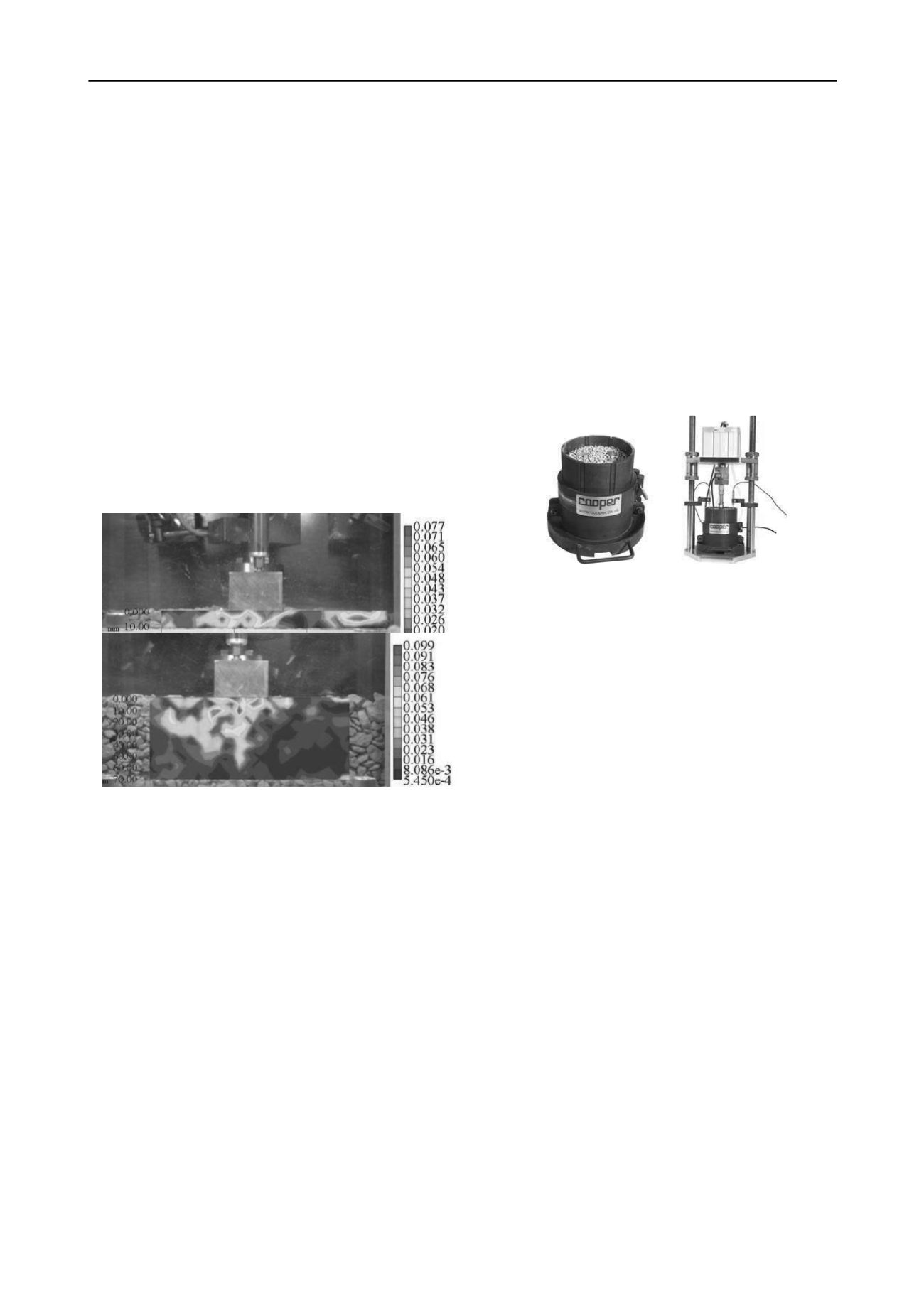
1215
Technical Committee 202 /
Comité technique 202
Calon et al. (2013) have studied the potential benefits from
the ground reinforcement by vertical soil-cement columns.
Laboratory tests are performed to study the influence of the
column location and the efficiency of geosynthetics on the
reduction of stiff zones effects. These tests together with
subsequent numerical modelling determined the optimum
column layout (depth, spacing and positioning) and the effects
of geosynthetics on the reduction of ballast damage.
Hayano et al. (2013) analysed the influence of ballast
thickness and tie-tamper repair on the settlement of tracks by
conducting a series of cyclic loading tests. Figure 5 shows the
shear strain distribution generated before the tie-tamper
implementation. This shear strain distribution is obtained using
the method of particle image velocimetry. They found that the
250 mm ballast thickness currently adopted as the standard
design is ineffective for minimizing settlement that occurs when
the nonlinearity of roadbed compressibility is relatively
moderate. Moreover, characteristics of the initial settlement
process are altered significantly after the tie-tamper
implementation, although the degree of gradual subsidence
undergoes minimal change regardless of ballast thickness and
roadbed type.
Figure 5. Distribution of maximum shear strain generated before tie-
tamper implementation . (Source: Fig 5, Hayano et al. 2013).
Mohanty and Chandra (2013) have reported a series of cyclic
load triaxial tests on reconstituted pond ash specimens at
different moisture content and stress levels simulating
environmental and traffic conditions. They concluded that both
traffic and environmental conditions play an important role in
the permanent axial strain behavior of the material.
Furthermore, within the design context, they also highlighted
the existence of a shakedown limit describing a critical stress
level between stable and unstable conditions.
A series of CBR tests was conducted by Moayed et al.
(2013) to investigate effects of lime-microsilica additive as a
modern additive stabilizer on a silty soil to use it as a subgrade.
They also evaluated the effects of the wetting-drying cycles.
The CBR values were found to increase significantly as the soil
was stabilized with lime-microsilica additive. An increase in the
CBR values of the stabilized soil owing to wetting-drying
cycles was also observed. Results showed that lime-microsilica
additive can successfully be considered as a suitable option to
stabilize silty soils.
Kumara and Hayano (2013) presented a series of cyclic
loading models to investigate the effects of sand intrusion into
ballast (i.e. fouling) and tie-tamping application on settlements
of ballasted rail track. They found that the initial settlement
process and the rate of residual settlement increases when the
ballast is mixed with more than 30% fine materials. Therefore,
tie-tamping application was found effective for fouled ballast
with less than 30% fines.
4 THEORETICAL ADVANCEMENTS AND
CONTRIBUTIONS TO DESIGN
A total of 7 articles are categorized in the area of theoretical
advancements and contributions to design. There are 6 papers
investigating the behavior of road embankments (Simic 2013,
Ohta et al. 2013, Shin et al. 2013, Vogt et al. 2013, Eekelen and
Bezuijen 2013, Brown and Thom 2013), while one article
reports the development of a non-linear ballasted track model
using the finite element technique (Fernandes et al. 2013).
Brown and Thom (2013) proposed a Precision Unbound
Materials Analyser (simplified version of the repeated load
triaxial test) to quantify both resilient and plastic strain
characteristics (Figure 6). Unlike CBR testing, this technique
can be very useful in allowing the designer to evaluate
alternative foundation material combinations in order to achieve
the desired bearing capacity.
Figure 6. The Precision Unbound Material Analyser (PUMA) (Source:
Fig 1, Brown and Thom 2013).
Simic (2013) adopted the average suction compression index
of the plate loading tests and the routine soil parameters to carry
out a comparison between the methods of estimating swelling.
It is found that the potential vertical rise method is overly
dependent on the active moisture depth, which should be
adopted in the design based on the local experience.
Ohta et al. (2013) proposed the structure of seismic retrofit
technique for asphalt concrete pavements using the Confined-
Reinforced Earth (CRE) principle. Construction method and the
results of full scale in-situ tests are well-described where the
crushed stones and the associated design procedures are clearly
introduced. Full-scale in-situ tests show the acceptable
performance of CRE after the forced settlement to simulate
severe earthquake-induced damage.
Shin et al. (2013) determined the frost penetration depth of
paved road using field measurements. They found that the
subbase and base courses were influenced by the temperature
below 0
Ԩ
regardless of the anti-frost layer. The frost
penetration depth, estimated by the empirical equation proposed
by Korea Institute of Construction Technology, shows a similar
trend at lower frost index. This design concept is proposed for
road design as an acceptable and reasonable approach.
Vogt et al. (2013) presented project-specific conditions
during the dumping process, and the properties of the dumped
soils along the future A-44 route. A simple model for the
description of the time-dependent deformation of the dump and
the effectiveness of soil compaction methods is discussed and
evaluated. The simulation results and geodetic measurements
reveal that by allowing a rest period of at least 6 months
between the end of the dumping process and the start of the
construction work, the settlements of structures and/or
pavements can be reduced significantly.
Eekelen and Bezuijen (2013) compared three equilibrium
models describing the phenomenon of arching in basal
geosynthetically reinforced (GR) piled embankments, namely
the models of Hewlett and Randolph (1988), Zaeske (2001) and
the model of concentric arches by Van Eekelen (2013b). The
load distributions predicted by Hewlett and Randolph (1988)
and Zaeske (2001) show a uniform load distribution on the GR
between the piles. The concentric arches model provides a load
concentration on the GR strips, with an inverse triangular load


